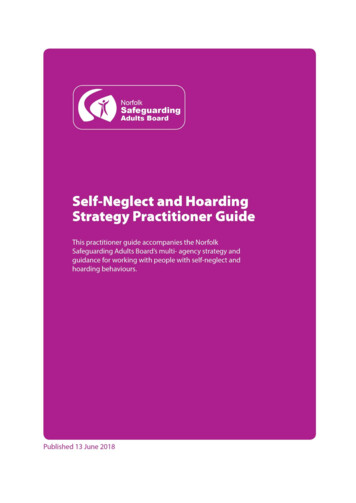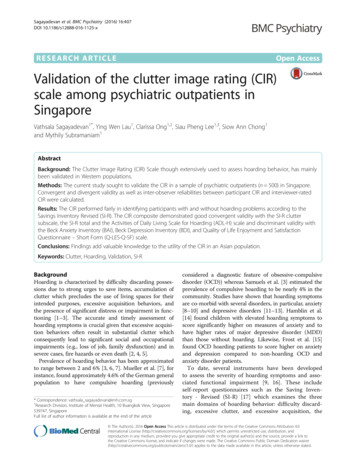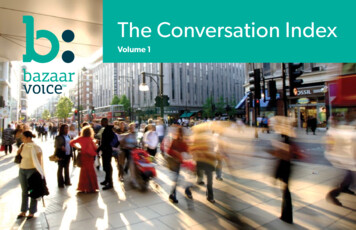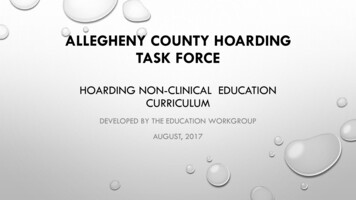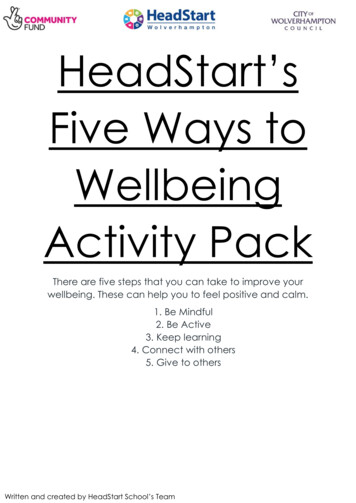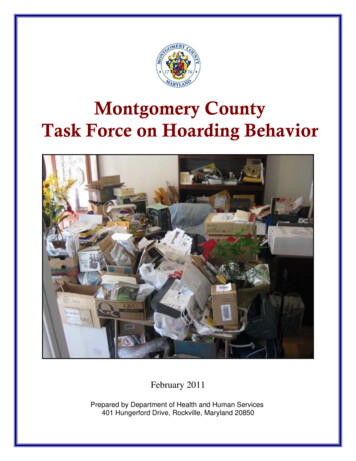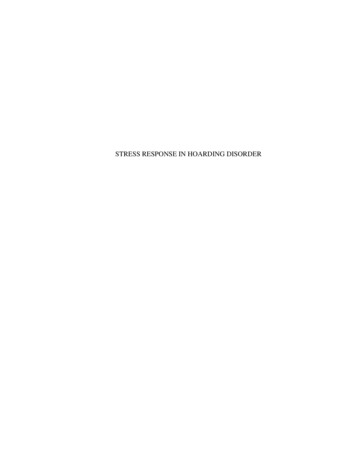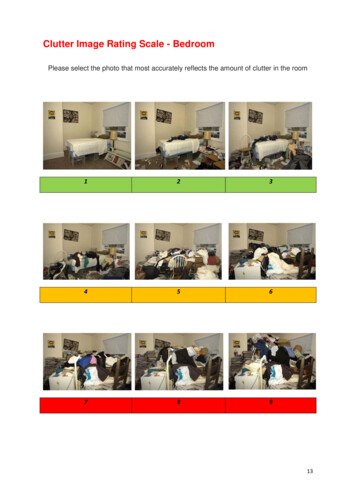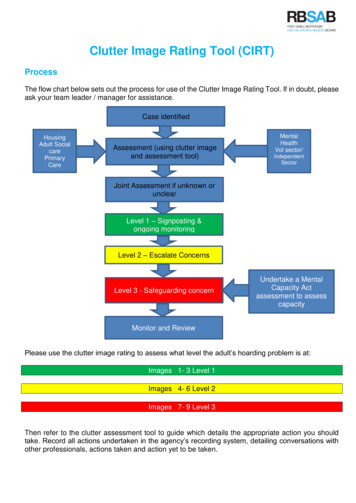
Transcription
Clutter Image Rating Tool (CIRT)ProcessThe flow chart below sets out the process for use of the Clutter Image Rating Tool. If in doubt, pleaseask your team leader / manager for assistance.Case identifiedHousingAdult SocialcarePrimaryCareAssessment (using clutter imageand assessment tool)MentalHealthVol sector/IndependentSectorJoint Assessment if unknown orunclearLevel 1 – Signposting &ongoing monitoringLevel 2 – Escalate ConcernsLevel 3 - Safeguarding concernUndertake a MentalCapacity Actassessment to assesscapacityMonitor and ReviewPlease use the clutter image rating to assess what level the adult’s hoarding problem is at:Images 1- 3 Level 1Images 4- 6 Level 2Images 7- 9 Level 3Then refer to the clutter assessment tool to guide which details the appropriate action you shouldtake. Record all actions undertaken in the agency’s recording system, detailing conversations withother professionals, actions taken and action yet to be taken.
Clutter Image Rating Scale- BedroomPlease select the photo that most accurately reflects the amount of clutter in the room123456789
Clutter Image Rating Scale - LoungePlease select the photo that most accurately reflects the amount of clutter in the room123456789
Clutter Image Rating Scale – KitchenPlease select the photo that most accurately reflects the amount of clutter in the room147258369
Assessment Tool GuidelinesSee Appendix 1 for guidance on questions which could be used during an assessment1. Property structureservices and gardenarea 2. Household Functions3. Health and Safety 4. Safeguard of Children& Family members5. Animals and Pests Assess the access to all entrances and exits for the property. (Noteimpact on any communal entrances & exits). Include access toroof space.Can the occupant escape from all rooms in the event of a fire orother emergency?Is there a clear plan of what to do in the event of a fire or otheremergency and does everyone in the home know it?Does the property have a working smoke alarm?Carry out a cursory visual assessment of the condition of theservices within the property e.g. plumbing, electrics, gas, airconditioning, heating; this will help inform your next course ofaction.Are the services connected?Assess the garden; size, access and condition.Assess the current functionality of the rooms and the safety fortheir proposed use. e.g. can the kitchen be safely used forcooking, can the occupier(s) properly use the bathroom/ WC ordoes the level of clutter within the room prevent their normal use.Select the appropriate rating on the clutter scale.Please estimate the % of floor space covered by clutterPlease estimate the height of the clutter in each roomAssess the level of sanitation in the property.Are the floors clean and are readily cleansed?Are the work surfaces clean?Are you aware of any odours in the property?Is there rotting food?Does the resident use candles, portable electric or gas heaters?Did you witness a higher than expected number of flies and otherinsects?Are household members struggling with personal care?Is there random or chaotic writing on the walls on the property?Are there unreasonable amounts of medication collected?(Prescribed or over the counter?)Is there evidence of illegal drug use?Is the resident aware of any fire risk associated to the clutter inthe property?Is there faecal matter, urine or other body fluids visible withinthe property?Do any rooms rate 7 or above on the clutter rating scale?Does the household contain young people or children?Are the any pets at the property?Are the pets well cared for; are you concerned about theirhealth?
6 Personal health and safety Is there evidence of any infestation? e.g. bed bugs, cockroaches,fleas, rats, mice, etc.Are animals being hoarded at the property? If so, are theyhealthy and being well looked after.Are outside areas seen by the resident as a wildlife area?Does the resident leave food out in the garden to feed foxes etc.Following your assessment do you recommend the use ofPersonal protective equipment (PPE) at future visits? Pleasedetail.Following your assessment do you recommend the resident isvisited in pairs or with the Police? Please detail.Clutter/ Hygiene rating frameworkLevel 1Clutter image rating 1-31. Property structure,services & gardenareaHousehold environment is considered reasonable. No specialisedassistance is needed. If the resident would like some assistance withgeneral housework or feels they are declining towards a higher clutterscale, appropriate referrals can be made subject to age andcircumstances. 2. Household Functions 3. Health and Safety All entrances and exits, stairways, roof space and windowsaccessible.Smoke alarms fitted and functional or referrals made to GreaterManchester Fire and Rescue for safe and well visit.All services functional and maintained in good working order.Garden is accessible, tidy and maintainedNo excessive clutter, all rooms can be safely used for theirintended purpose.All rooms are rated 0-3 on the Clutter Rating ScaleNo additional unused household appliances appear in unusuallocations around the propertyProperty is maintained within terms of any lease or tenancyagreements where appropriate.Property is not at risk of action by Environmental Health.Property is clean with no odours, (pet or other)No rotting foodNo concerning use of candles or other fire risks.No concern over fliesResidents managing personal careNo writing on the wallsQuantities of medication are within appropriate limits, in dateand stored appropriately.No safety or health concern regarding drugs, alcohol or smoking.
4. Safeguard of Children& Family members No concerns for household members.5. Animals and Pests Any pets at the property are well cared forNo pests or infestations at the property6. Personal health andsafety No Personal protective equipment(PPE) requiredNo visit in pairs required.Clutter/ Hygiene Rating Level 1: ActionsLevel 11. Agency holding thecase 2. EnvironmentalHealth3. Social LandlordsActionsDiscuss concerns with residentRaise a request to the GM Fire and Rescue Service to provide firesafety as part of a safe and well visit.Refer for support assessment if appropriate.Refer to GP if appropriateNo Action Provide details on debt advice if appropriate to circumstancesRefer to GP if appropriateRefer for support assessment if appropriate.Provide details of support streams open to the resident via charitiesand self-help groups.Provide details on debt advice if appropriate to circumstancesEnsure residents are maintaining all tenancy conditions4. Practitioners Complete Hoarding AssessmentMake appropriate referrals for supportRefer to social landlord if the client is their tenant or leaseholder5. Emergency Services Ensure information is shared with statutory agencies & feedback isprovided to referring agency on completion of home visits.6. Animal WelfareNo action unless advice requested7. Safeguarding Adults8. EHASHNo action unless other concerns of abuse are noted.Consider referring any children or young persons present to Early Helpunless other sources of abuse are noted, in which case refer to EHASH.Level 2Clutter image rating 46Property structure,services & garden areaHousehold environment requires professional assistance to resolve theclutter and the maintenance issues of the property. Only major exit is blockedOnly one of the services is not fully functionalConcern that services are not well maintained
Household Functions Health and SafetySafeguard of Children& Family members Animals and PestsPersonal health andsafety Smoke alarms are not installed or not functioningGarden is not accessible due to clutter, or is not maintainedEvidence of indoor items stored outsideEvidence of light structural damage including dampInterior doors missing or blocked openClutter is causing congestion in the living spaces and is impacting onthe use of the rooms for their intended purpose.Clutter is causing congestion between the rooms and entrances.Room(s) scores between 4-5 on the clutter scale.Inconsistent levels of housekeeping throughout the propertySome household appliances are not functioning properly and theremay be additional units in unusual places.Property is not maintained within terms of lease or tenancyagreement where applicable.Evidence of outdoor items being stored insideKitchen and bathroom are not kept cleanOffensive odour in the propertyResident is not maintaining safe cooking environmentSome concern with the quantity of medication, or its storage orexpiry dates.No rotting foodNo concerning use of candles or cigarettesResident trying to manage personal care but strugglingHoarding on clutter scale 4 - 7 doesn’t automatically constitute aSafeguarding Alert.Please note all additional concerns for householdersProperties with children or vulnerable residents with additionalsupport needs may trigger a Safeguarding Alert under a differentrisk.Pets at the property are not well cared forResident is not unable to control the animalsAnimal’s living area is not maintained and smellsAnimals appear to be under nourished or over fedSound of mice heard at the property.Spider webs in houseLight insect infestation (bed bugs, lice, fleas, cockroaches, ants, etc.)Refer to RSPCA for advice and guidance.Latex Gloves, boots or needle stick safe shoes, face mask, handsanitizer, insect repellent.Personal protective equipment required.Clutter /Hygiene rating Level 2 ActionsLevel 2Agency holding thecase ActionsRefer to landlord if resident is a tenantRefer to Environmental HealthRaise an request to the GM Fire and Rescue Service to provide fireprevention advice and a safe and well visit.Provide details of garden services
Environmental HealthSocial LandlordsPractitionersEmergency ServicesAnimal WelfareSafeguarding AdultsEHASHLevel 3Clutter image rating 7-9Property structure,services & garden areaRefer for support assessmentReferral to GPReferral to debt advice if appropriateRefer to Animal welfare if there are animals at the property.Ensure information sharing with all agencies involved to ensure acollaborative approach and a sustainable resolution. Refer to Environmental Health with details of client, landlord (ifrelevant) referrer’s details and overview of problems whereappropriate At time of inspection, Environmental Health Officer decides onappropriate course of action Consider serving notices under Public Health Act1936,Environmental Protection Act 1990, Prevention of Damage ByPests Act 1949 or Housing Act 2004 Consider Works in Default if notices not complied with by occupier Visit resident to inspect the property & assess support needs Refer for housing related support. Ensure residents are maintaining all tenancy conditions Enforce tenancy conditions relating to residents responsibilities Ensure information sharing with all agencies involved to ensure acollaborative approach and a sustainable resolution. Refer to “Guidance for Hoarding Guidance Questions to Ask” Complete Practitioners Assessment Tool Ensure information sharing with all agencies involved to ensure acollaborative approach and a sustainable resolution. Ensure information sharing with all agencies involved to ensure acollaborative approach and a sustainable resolution. Provide feedback to referring agency on completion of home visits. Visit property to undertake a wellbeing check on animals at theproperty. Educate client regarding animal welfare if appropriate- seek advicefrom the RSPCA. Provide advice / assistance with re-homing animalsNo action unless other concerns of abuse are noted.If other concerns of abuse are of concern or have been reported,progression to safeguarding referral and investigation may benecessary.Consider referring any children or young persons present to Early Helpunless other sources of abuse are noted, in which case refer to EHASH.Household environment will require intervention with a collaborativemulti-agency approach with the involvement from a wide range ofprofessionals. This level of hoarding constitutes a Safeguarding alertdue to the significant risk to health of the householders, surroundingproperties and residents. Residents are often unaware of theimplication of their hoarding actions and oblivious to the risk it poses. Limited access to the property due to extreme clutter Evidence may be seen of extreme clutter seen at windows
Evidence may be seen of extreme clutter outside the propertyGarden not accessible and extensively overgrownServices not connected or not functioning properlySmoke alarms not fitted or not functioningProperty lacks ventilation due to clutterInterior doors missing or blocked openEvidence of structural damage or outstanding repairs includingdampThere may be evidence of internal damp and / or mould.Evidence of indoor items stored outsideClutter is obstructing the living spaces and is preventing the use ofthe rooms for their intended purpose.Room(s) scores 7 - 9 on the clutter image scaleRooms not used for intended purposes or very limitedBeds inaccessible or unusable due to clutter or infestationEntrances, hallways and stairs blocked or difficult to passToilets, sinks not functioning or not in useResident at risk due to living environmentHousehold appliances are not functioning or inaccessibleResident has no safe cooking environmentResident is using candles, electric or gas heating appliancesDiscarded cigarettes in the propertyEvidence of outdoor clutter being stored indoors.No evidence of housekeeping being undertakenBroken household items not discarded e.g. broken glass or platesConcern for declining mental healthProperty is not maintained within terms of lease or tenancyagreement where applicableProperty is at risk of notice being served by Environmental HealthHuman urine and or excrement may be presentExcessive odour in the property, may also be evident from theoutsideRotting food may be presentEvidence may be seen of unclean, unused and or buried plates &dishes.Broken household items not discarded e.g. broken glass or platesInappropriate quantities or storage of medication.Pungent odour can be smelt inside the property and possibly fromoutside.Concern with the integrity of the electricsInappropriate use of electrical extension cords or evidence ofunqualified work to the electrics.Concern for declining mental healthEvidence of excessive use of drugs, alcohol or cigarettes.Safeguard of Children & Family members Animals and Pests Hoarding on clutter scale 7-9 constitutes a Safeguarding Alert.Please note all additional concerns for householdersAnimals at the property at risk due the level of clutter in the propertyHousehold Functions Health and Safety
Personal health andsafetyActionsAgency holding thecaseEnvironmental HealthLandlordPractitionersEmergency ServicesAnimal WelfareSafeguarding AdultsEHASHResident may not able to control the animals at the propertyAnimal’s living area is not maintained and smellsAnimals appear to be under nourished or over fedHoarding of animals at the propertyHeavy insect infestation (bed bugs, lice, fleas, cockroaches, ants,silverfish, etc.) Visible rodent infestation Refer to RSPCA Visits where Personal protective equipment (PPE) required: i.e.Latex Gloves, boots or needle stick safe shoes, face mask, handsanitizer, insect repellent.Level 3 Raise Safeguarding concern within 24 hours Raise a request to the GM Fire and Rescue Service within 24 hoursto provide priority safe and well visit. Refer to Environmental Health with details of client, landlord (ifrelevant) referrer’s details and overview of problems At time of inspection, EHO decides on appropriate course of action Consider serving notices under Public Health Act 1936,Environmental Protection Act 1990, Prevention of Damage By PestsAct 1949 or Housing Act 2004 Consider Works in Default if notices not complied by occupier Visit resident to inspect the property & assess support needs Attend multi agency MRM meeting Enforce tenancy conditions relating to residents responsibilities If resident refuses to engage serve Notice of Seeking Possessionunder Ground 13 to Schedule 2 of the Housing Act 1988 Refer to “Hoarding Guidance Questions for practitioners” SeeAppendix 1 Complete Practitioners Assessment Tool Ensure information sharing with all agencies involved to ensure acollaborative approach and a sustainable resolution. Attend multi agency MRM meeting on request Ensure information sharing with all agencies involved to ensure acollaborative approach and a sustainable resolution. Provide feedback to case holding agency on completion of homevisits. Notify the RSPCA for further advice and guidance. Visit property to undertake a wellbeing check on animals at theproperty. Remove animals to a safe environment Educate client regarding animal welfare if appropriate Take legal action for animal cruelty if appropriate Provide advice / assistance with re-homing animalsSafeguarding concern should progress to section 42 enquiry for multiagency approach and further investigation of any concerns of abuse.Multi-agency strategy meeting required.Refer to EHASH if children or young people present within 24 hours
Guidance for Practitioners (from all agencies)Hoarding Insight characteristicsUse this guide as a baseline to describe the client’s attitude towards their hoarding.Provide additional information in your referrals and reports to enable a tailoredapproach that is relevant to you client.Good or fair insight:The client recognises that hoarding – related beliefs and behaviours (relating todifficulty discarding items, clutter or excessive acquisition) are problematic. The clientrecognises these behaviours in themselves.Poor insightThe client is mostly convinced that hoarding – related beliefs and behaviours (relatingto difficulty discarding items, clutter or excessive acquisition) are not problematicdespite evidence to the contrary. The Client might recognise a storage problem buthas little self – recognition or acceptance of their own hoarding behaviour.Absent (delusional) insightThe Client is convinced that hoarding- related beliefs and behaviours (relating todifficulty discarding items, clutter or excessive acquisition) are not problematic despiteevidence to the contrary. The Client is completely accepting of their living environmentdespite the hoarding and possibly a risk to health.Detached with assigned blameThe client has been away from their property for an extended period. The client hasformed a detachment from the hoarded property and is now convinced a 3 rd party isto blame for the condition of the property. For example a burglary has taken place,squatters or other household members
Practitioners Hoarding AssessmentThis assessment tool below will be completed by a practitioner of the agency holdingthe case in order to decide whether this case should be addressed through a multiagency strategy meeting, or if this can be managed ‘in-house’ with the support ofpartners.Date of home assessmentClients NameClients date of birthAddressClient contact detailsType of dwellingOwneroccupierLeaseholderHousehold MembersTenant - Nameand address oflandlordNameRelationshipDate of birthPets - indicate what pets and anyconcernsAgencies currently involved - withcontact detailsNon agency support currently inplaceClients attitude towards hoardingPlease indicate if present at the propertyStructuralInsect ordamage torodentpropertyinfestationLarge numberof animalsClutteroutside
Rotten foodAnimal wastein houseConcern ofself- neglectConcerned forchildren at thepropertyConcerns overthe cleanlinessof thepropertyConcerned forother adults atthe propertyVisiblehumanfaecesEvidence ofsmall burnmarks inthepropertyUsing the Clutter Image Scale please score each of the room belowBedroom 1Bedroom 4Separate toiletBedroom 2KitchenLoungeBedroom 3BathroomDining RoomPlease provide a description of the hoarding problem ;( presence of human or animal waste, rodents orinsects, rotting food, are utilities operational, structural damage, problems with blocked exits, are therecombustibles, is there a fire risk?Please refer to the multi-agency hoarding Strategy and Guidance Document tool, based on the informationprovided above, what level is your case graded?Level 1 GreenLevel 2 OrangeLevel 3 RED- Take case toHigh Risk PanelName of practitionerundertaking assessmentName of organisationsContact detailsNext actions to be takenList of agencies refereed towith dates and contact names
References and further information Bath and North East Somerset Local Safeguarding Adults Board (n.d.)Guidance to staff on managing self-neglect. Retrieved frombathnes.gov.uk/sites/default/files/self neglect guidance pdf.pdfGibbons et al (2006) Self-Neglect: A proposed new NANDA diagnosis,International Journal of Nursing Terminologies and Classifications, 17 (1), pp10-18.Help for Hoarders http://www.helpforhoarders.co.ukSCIE (2011) Self-neglect and adult safeguarding: findings from research(Report 46) available from www.scie.org.ukSuffolk County Council – Multi – agency policy and procedures in respondingto concerns of Self Neglect.London Borough of Merton - Multi - agency Hoarding Protocol.London Borough of Camden. High Risk Panels.GMFRS hoarding prevention and protection guidance
Please use the clutter image rating to assess what level the adult's hoarding problem is at: Images 1- 3 Level 1 Images 4- 6 Level 2 . Room(s) scores between 4-5 on the clutter scale. Inconsistent levels of housekeeping throughout the property
